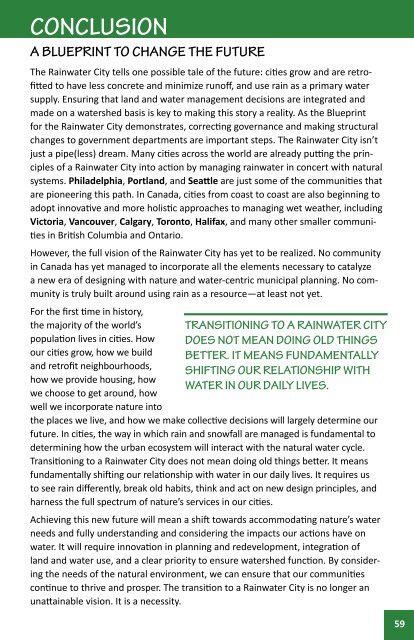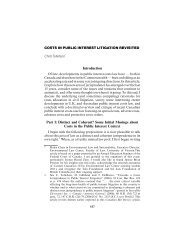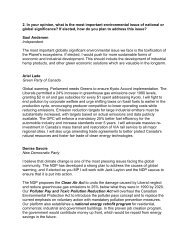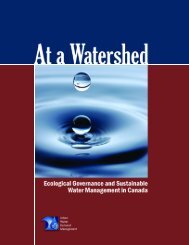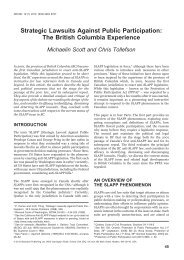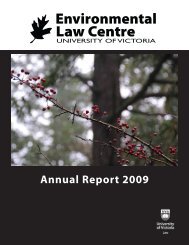Peeling back the Pavement - POLIS Water Sustainability Project
Peeling back the Pavement - POLIS Water Sustainability Project
Peeling back the Pavement - POLIS Water Sustainability Project
You also want an ePaper? Increase the reach of your titles
YUMPU automatically turns print PDFs into web optimized ePapers that Google loves.
CONCLUSION<br />
A BLUEPRINT TO CHANGE THE FUTURE<br />
The Rainwater City tells one possible tale of <strong>the</strong> future: cities grow and are retrofitted<br />
to have less concrete and minimize runoff, and use rain as a primary water<br />
supply. Ensuring that land and water management decisions are integrated and<br />
made on a watershed basis is key to making this story a reality. As <strong>the</strong> Blueprint<br />
for <strong>the</strong> Rainwater City demonstrates, correcting governance and making structural<br />
changes to government departments are important steps. The Rainwater City isn’t<br />
just a pipe(less) dream. Many cities across <strong>the</strong> world are already putting <strong>the</strong> principles<br />
of a Rainwater City into action by managing rainwater in concert with natural<br />
systems. Philadelphia, Portland, and Seattle are just some of <strong>the</strong> communities that<br />
are pioneering this path. In Canada, cities from coast to coast are also beginning to<br />
adopt innovative and more holistic approaches to managing wet wea<strong>the</strong>r, including<br />
Victoria, Vancouver, Calgary, Toronto, Halifax, and many o<strong>the</strong>r smaller communities<br />
in British Columbia and Ontario.<br />
However, <strong>the</strong> full vision of <strong>the</strong> Rainwater City has yet to be realized. No community<br />
in Canada has yet managed to incorporate all <strong>the</strong> elements necessary to catalyze<br />
a new era of designing with nature and water-centric municipal planning. No community<br />
is truly built around using rain as a resource—at least not yet.<br />
For <strong>the</strong> first time in history,<br />
<strong>the</strong> majority of <strong>the</strong> world’s<br />
population lives in cities. How<br />
our cities grow, how we build<br />
and retrofit neighbourhoods,<br />
how we provide housing, how<br />
we choose to get around, how<br />
well we incorporate nature into<br />
Transitioning to a Rainwater City<br />
does not mean doing old things<br />
better. It means fundamentally<br />
shifting our relationship with<br />
water in our daily lives.<br />
<strong>the</strong> places we live, and how we make collective decisions will largely determine our<br />
future. In cities, <strong>the</strong> way in which rain and snowfall are managed is fundamental to<br />
determining how <strong>the</strong> urban ecosystem will interact with <strong>the</strong> natural water cycle.<br />
Transitioning to a Rainwater City does not mean doing old things better. It means<br />
fundamentally shifting our relationship with water in our daily lives. It requires us<br />
to see rain differently, break old habits, think and act on new design principles, and<br />
harness <strong>the</strong> full spectrum of nature’s services in our cities.<br />
Achieving this new future will mean a shift towards accommodating nature’s water<br />
needs and fully understanding and considering <strong>the</strong> impacts our actions have on<br />
water. It will require innovation in planning and redevelopment, integration of<br />
land and water use, and a clear priority to ensure watershed function. By considering<br />
<strong>the</strong> needs of <strong>the</strong> natural environment, we can ensure that our communities<br />
continue to thrive and prosper. The transition to a Rainwater City is no longer an<br />
unattainable vision. It is a necessity.<br />
59


